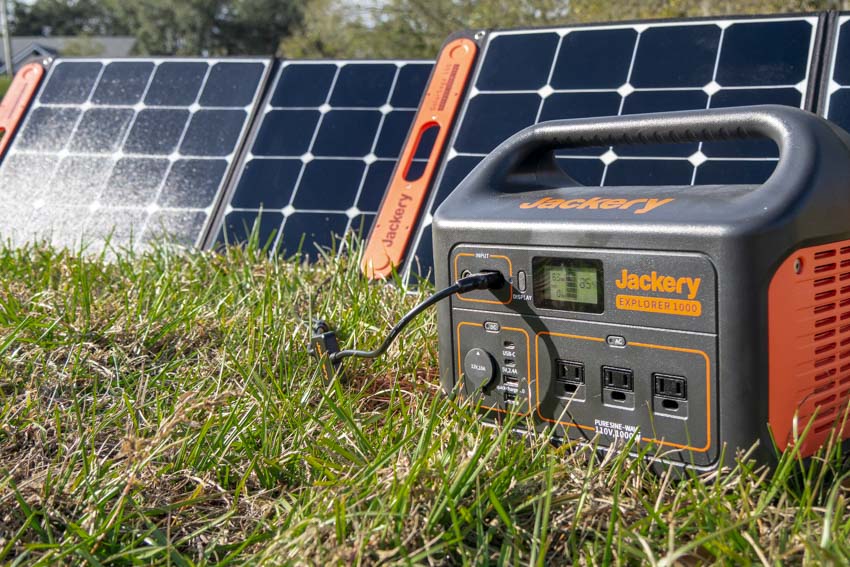Jackery Explorer 1000 and 1000 PRO Solar Generators Find a Niche Between Compact and High-Capacity Battery Inverters
The age of lithium-ion power is giving us energy options for nearly every aspect of our lives. We’ve tested battery inverters as cleaner options over gas generators for running power tools. The Jackery Explorer 1000 and 1000 PRO solar generators aren’t at that voltage level, but these compact power sources make a solid case to keep them on hand for other applications.
Pros
- Excellent energy capacity in a highly portable package
- Very nice combination of 110V AC, USB-C, USB, and 12V charging ports
- Travel-friendly solar panel design
Cons
- Solar panels are more expensive than other brands
Editor’s Note: Check out our best generators article to get our top overall picks for all types of generators.
Jackery Explorer 1000 Solar Generator Portability
Right out of the gate, we fell in love with the Jackery 1000 solar generator’s size. Measuring 13.1 x 9.2 inches and standing 11.1 inches tall, it doesn’t take up a ton of space. Weighing about 22 pounds, it’s easier to carry than higher-capacity options. The more compact 1000 PRO accomplishes a similarly compact size at 13.4 x 10.3 x 10.1 inches (WxDxH). It weighs 25.4 pounds—just a touch more than the Explorer 1000.

Jackery Explorer 1000/PRO Battery Inverter Power
The Jackery Explorer 1000 is capable of 1000 continuous watts and 2000 surge watts. That’s better than most of the compact inverters out there and less than you can get with something like the EGO Nexus Power Station or Goal Zero Yeti 3000. While those are capable of running almost anything you can plug into a standard 110V outlet, the Explorer 1000 is limited to about 9 amps at 120 volts.
The Explorer 1000 PRO also delivers the same continuous and peak wattage. It drops the maximum rated wattage on the 120V outlets to 8.3 watts. Despite the reduced size of the 1000 PRO, it doesn’t reduce the maximum amount of battery capacity: 1002Wh.
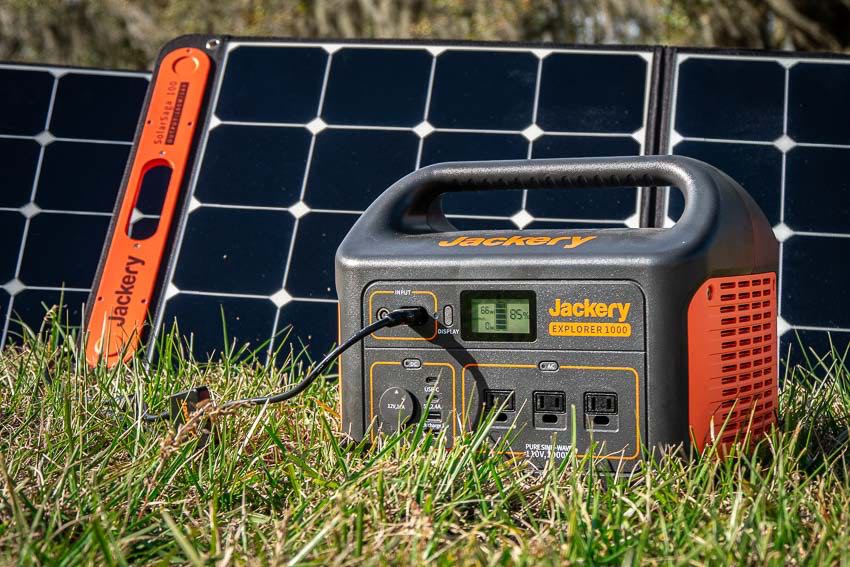
Here are a handful of items you can power from our passions for power tools and the outdoors:
- Oscillating multi-tools
- Small angle grinders
- Some sanders
- Jigsaws
- Rotary tools (Dremels)
- Power tool battery chargers
- Laptop, tablet, phone, and camera chargers
- Most LED lights
- Small fans
- Electric grill
- Mini fridge
- Coffee maker
- Slow cooker
- Instapot
Because the Jackery Explorer 1000 and 1000 PRO both produce pure sine wave power, you don’t have to worry about your electronics. Go right ahead and run them to your heart’s content.
Jackery Explorer 1000 and 1000 PRO Inverter Plugs
As far as connections go, Jackery gives you a nice mix.
- 3 x 110V AC
- 2 x USB C
- 2 x USB (1 each 2.4A and 3.0A)
- 1 x 12V (10A)
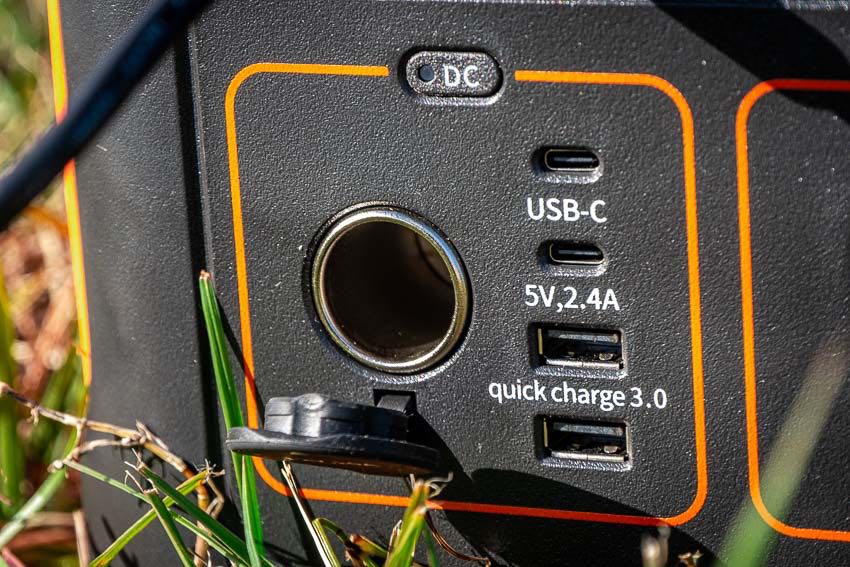
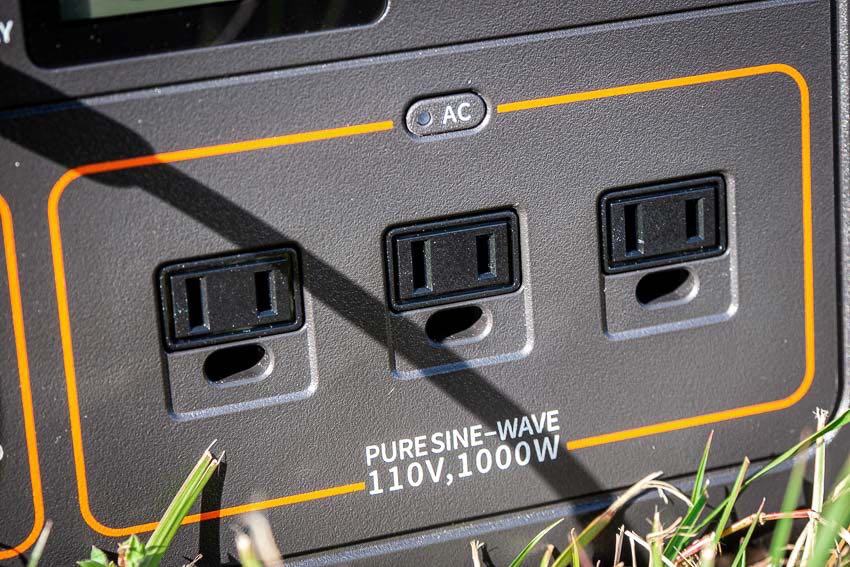
Both the AC and DC plugs have a power switch to activate them. It means you have to remember to hit it before they’re active, but neither draw down the power when you’re not using the unit.
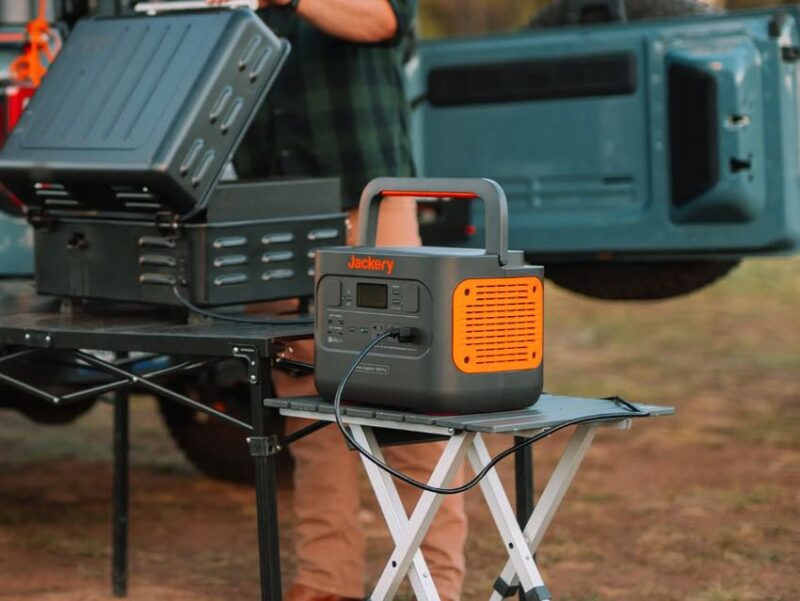
Jackery Explorer 1000 Power Station Runtime
Your runtime will vary depending on how much power your device uses. The Explorer 1000 has a total capacity of 1002Wh. To get a good runtime estimate, take 1002 and divide the watt rating of what you’re running into it.
Here’s an example using a 6-amp (660 watts) jigsaw:
1002Wh / 660W = 1.52 hours (~ 91 minutes)
Jackery Explorer Solar Generator Charging
There are three primary ways to charge any of the Explorer models: wall outlet, vehicle outlet, and solar. Technically, you can also charge it with another generator/inverter if you really want to.
The wall outlet is your quickest option, taking about 7 hours (Explorer 1000) or <2 hours (Explorer 1000 PRO) to fully recharge the battery. You’ll need to be patient if you want to use a vehicle—it’ll take about 12-14 hours.
Solar charging is one of the big draws for any battery inverter, so let’s spend a bit more time talking about that. Our test unit came with two SolarSaga 100 panels for a total of 200 solar watts. With the Explorer 1000 PRO you can get these or a pair of 80W panels.
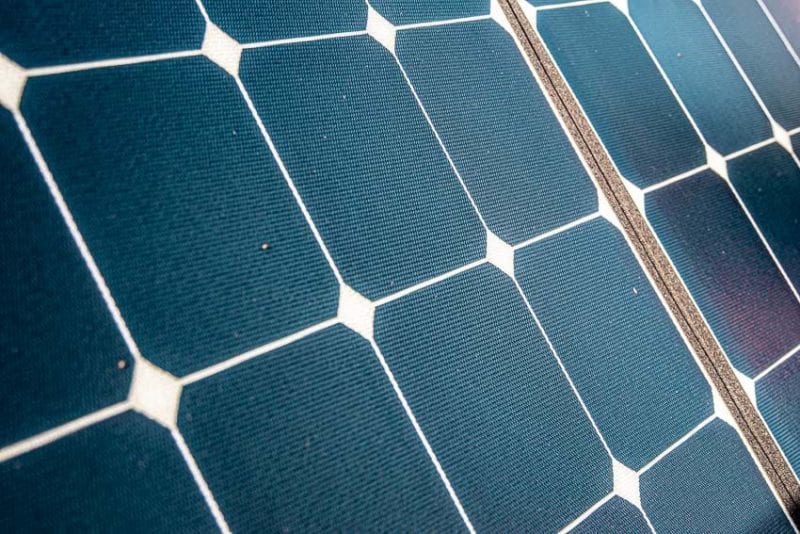
First of all, we LOVE the design compared to other solar panels we’ve used. The SolarSaga panels are flexible and fold up suitcase style. They feel much more travel-friendly in their design and weigh less than others we’ve tested. The 80W versions have handles on top but otherwise appear similar to the 100W versions.
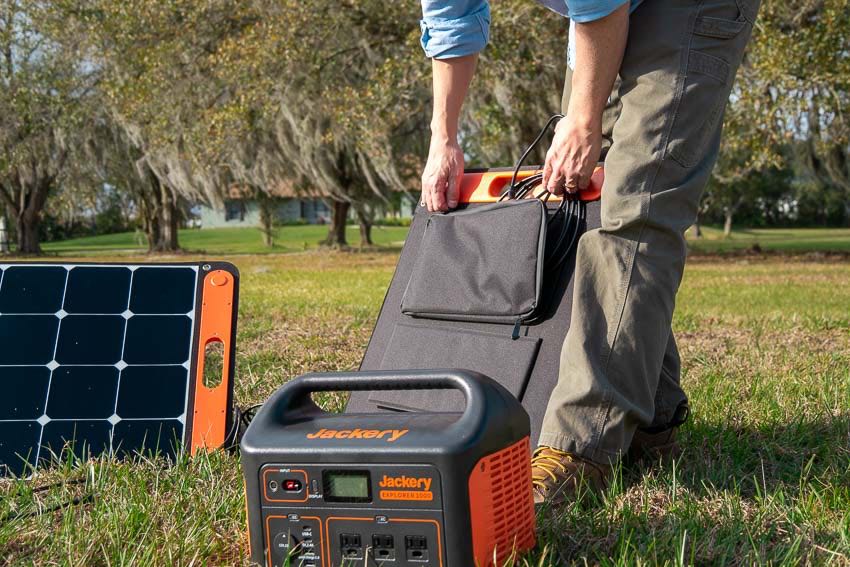
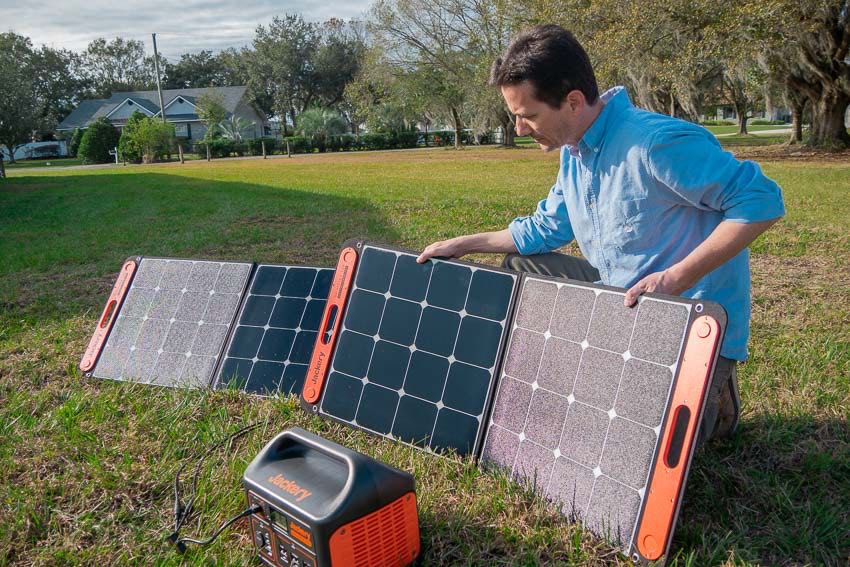
Most of our original testing took place in December and early January when the sun was about as far south as it gets during the year. We pulled 125 watts peak and were very happy with that efficiency level. Assuming you turn your panels to keep up with the sun as it travels and there are no clouds, you can easily get a full charge in roughly 8-9 hours.
Display
The backlight display is simple, yet helpful. It lets you know how many watts the system is discharging during use or gaining while charging. There’s also a 5-bar battery level indicator along with a 0% – 100% digital display. The Explorer 1000 PRO features a more colorful and sophisticated inverted LCD display that we prefer when used in full sunlight.
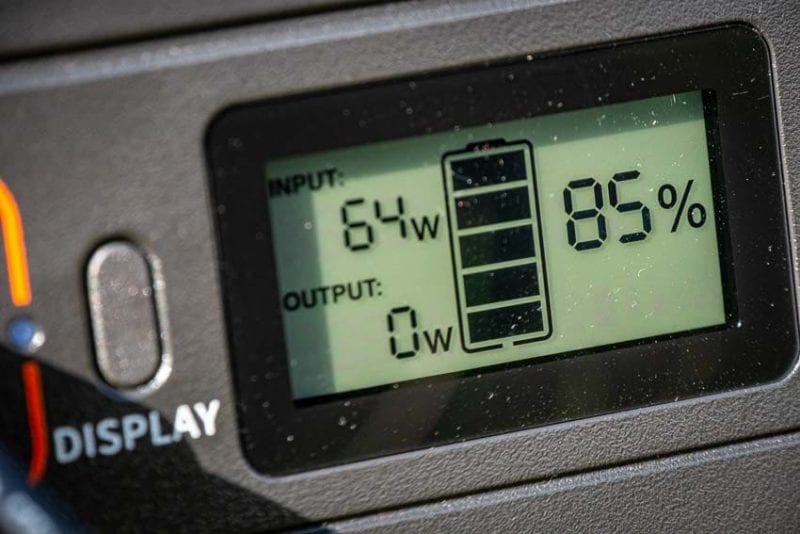
LED Light
There’s an LED flashlight on the side. It’s okay to use in a pinch, but we prefer a headlamp or handheld flashlight. At the end of the day, it’s a non-factor when it comes to buying the unit or not in our opinion.
Jackery Explorer 1000 vs 1000 PRO
| Explorer 1000 | Explorer 1000 PRO | |
|---|---|---|
| Battery type | Li-ion NMC | Li-ion |
| Battery capacity | 1002Wh (21.6V, 46.4Ah) | 1002Wh (43.2V 23.2Ah) |
| Lifecycle | 500 cycles to 80%+ capacity | 1000 cycles to 80%+ capacity |
| Recharge time (AC) | 7 hours | 1.8 hours |
| Recharge time (12V) | 14 hours | 12 hours |
| USB-A outputs (2) | 5V, 2.4A + QC 3.0 | 2 x QC 3.0 |
| USB-C outputs (2) | 12V, 10A | 5V-20V, 3A-5A |
| AC outputs (3) | 110VAC, 60Hz, 1000W (2000W Surge) | 120VAC, 60Hz, 1000W (2000W Surge) |
| Foldable handle | No | Yes |
| Dimensions (LxWxD) | 13.1 x 9.2 x 11.1 in | 13.4 x 10.3 x 10.1 in |
| Weight | 22.04 lbs | 25.4 lbs |
| Warranty | 2 years | 3+2 years |
| Retail Price | $999 | $1099 |
How Much Do the Jackery Explorer 1000 and 1000 PRO Cost?
Both the Jackery Explorer 1000 and 1000 PRO solar generators run between $999 and $1099.99 for the power station. Considering both output and capacity, that’s a pretty good value compared to other battery inverters on the market.
It’s $1649 as a kit with either two 100-watt solar panels (Explorer 1000) or two 80W panels (Explorer PRO). ~$299.99 for each solar panel is more than we see from other brands. However, they’re better designed for travel and make it worth the premium if you’re on the go frequently.
Jackery is throwing a flash sale with up to 20% off on selected products during April 14–22. Don’t miss the chance to snag one for your spring getaway!
The Bottom Line
The Jackery Explorer 1000 battery inverter and its similar Explorer 1000 PRO find themselves in an interesting niche. While they don’t have the capacity and power output of larger inverters, both provide a nice step up from compact units. Both also retain a high level of portability. If you’re on the go frequently and are primarily concerned about low-draw devices, either the 1000 or 1000 PRO offers an excellent solution to keep you powered up.
Clearly, the advantage in several areas goes to the newer 1000 PRO. In particular, we like the extra year warranty (3 more years if you register), the faster AC charging, and the higher USB capabilities. We also like the folding handle which makes room for setting (safe) things on top of it. Still, when new models come out, older models suddenly find themselves selling at value prices—so keep an eye out for deals.
Specifications (Explorer 1000/1000 PRO)
- Battery Capacity: 1002Wh (21.6V, 46.4Ah)/1002Wh (43.2V, 23.2Ah)
- Cell Chemistry: Li-Ion NMC/Li-ion
- Lifecycles: 500/1000 cycles to 80%
- Management System: BMS, Over Voltage Protection, Short Circuit Protection
- Recharge Time:
- AC Adapter Recharge Time: 7/1.8 hours
- 12V Car Adapter Recharge Time: 14/12 hours
- 2x SolarSaga 100W Solar Panels Recharge Time: 8 hours (Explorer 1000)
- 2x SolarSaga 80W Solar Panel: 9 Hours (Explorer 1000 PRO)
- AC Output: 110VAC, 60 Hz 1000W (2000W Surge)
- USB-A#1 Output: 5V, 2.4A/QC 3.0, 18W Max
- USB-A#2 Output: QC 3.0 Output: 5-6.5V, 3A/6.5-9V, 3A/9-12V, 15A (Explorer 1000)
- USB-C Output: 5V, 9V, 12V up to 3A/5-20V, 3-5A
- Car Output: 12V, 10A
- DC Input (Explorer 1000): 12V-30V (163W)
- DC Input (Explorer 1000 PRO): 12V-17.5V(Working Voltage)⎓8A Max, Double to 16A Max; 17.5V-60V (Working Voltage)⎓11A, Double to 22A/800W Max
- Weight: 22.04/25.4 lbs.
- Dimensions (LxWxD): 13.1 x 9.2 x 11.1 in./13.4 x 10.3 x 10.1 in
- Operating Usage Temperature: 14-104ºF
- Certification: FCC, ROHS, UN38.3
- Warranty: 24 months/3+2 years info
- Price: $1099 (Bare Tool); $1,649 (with two SolarSaga Solar Panels)

